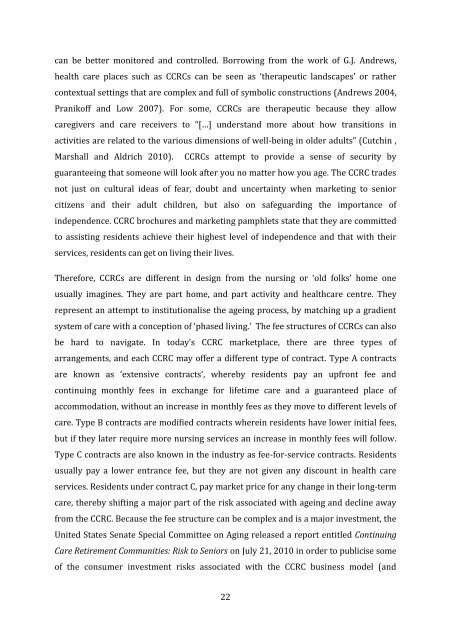Philip Y. Kao PhD thesis - Research@StAndrews:FullText
Philip Y. Kao PhD thesis - Research@StAndrews:FullText
Philip Y. Kao PhD thesis - Research@StAndrews:FullText
You also want an ePaper? Increase the reach of your titles
YUMPU automatically turns print PDFs into web optimized ePapers that Google loves.
can be better monitored and controlled. Borrowing from the work of G.J. Andrews,<br />
health care places such as CCRCs can be seen as ‘therapeutic landscapes’ or rather<br />
contextual settings that are complex and full of symbolic constructions (Andrews 2004,<br />
Pranikoff and Low 2007). For some, CCRCs are therapeutic because they allow<br />
caregivers and care receivers to “[…] understand more about how transitions in<br />
activities are related to the various dimensions of well-being in older adults” (Cutchin ,<br />
Marshall and Aldrich 2010). CCRCs attempt to provide a sense of security by<br />
guaranteeing that someone will look after you no matter how you age. The CCRC trades<br />
not just on cultural ideas of fear, doubt and uncertainty when marketing to senior<br />
citizens and their adult children, but also on safeguarding the importance of<br />
independence. CCRC brochures and marketing pamphlets state that they are committed<br />
to assisting residents achieve their highest level of independence and that with their<br />
services, residents can get on living their lives.<br />
Therefore, CCRCs are different in design from the nursing or ‘old folks’ home one<br />
usually imagines. They are part home, and part activity and healthcare centre. They<br />
represent an attempt to institutionalise the ageing process, by matching up a gradient<br />
system of care with a conception of ‘phased living.’ The fee structures of CCRCs can also<br />
be hard to navigate. In today’s CCRC marketplace, there are three types of<br />
arrangements, and each CCRC may offer a different type of contract. Type A contracts<br />
are known as ‘extensive contracts’, whereby residents pay an upfront fee and<br />
continuing monthly fees in exchange for lifetime care and a guaranteed place of<br />
accommodation, without an increase in monthly fees as they move to different levels of<br />
care. Type B contracts are modified contracts wherein residents have lower initial fees,<br />
but if they later require more nursing services an increase in monthly fees will follow.<br />
Type C contracts are also known in the industry as fee-for-service contracts. Residents<br />
usually pay a lower entrance fee, but they are not given any discount in health care<br />
services. Residents under contract C, pay market price for any change in their long-term<br />
care, thereby shifting a major part of the risk associated with ageing and decline away<br />
from the CCRC. Because the fee structure can be complex and is a major investment, the<br />
United States Senate Special Committee on Aging released a report entitled Continuing<br />
Care Retirement Communities: Risk to Seniors on July 21, 2010 in order to publicise some<br />
of the consumer investment risks associated with the CCRC business model (and<br />
22
















